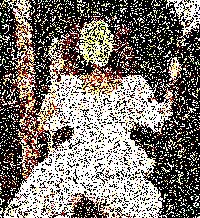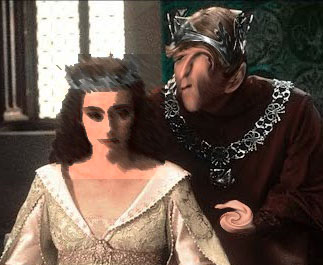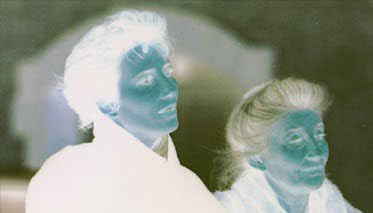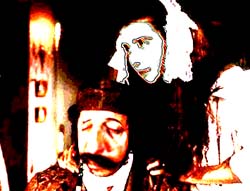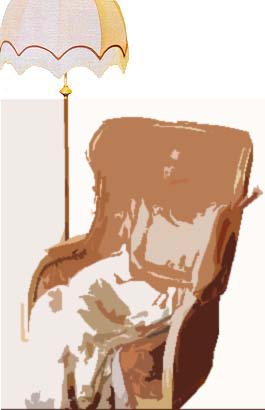Travelogue: Scotland 8/25/06-9/8/06
Introduction
Who is the Duchesse d'Antan?
A brief biography
"Mais ou sont les neiges d'antan?"
The Duchesse d'Antan was born Lucinda McDougle , on April 25, 1956, in Glasgow, to Leif McDougle and Delphia Legis, instructors in the drama school of Glasgow's Royal Scottish Academy of Music and Drama (RSAMD) . They also managed their own repertory company, the Merry -Go- Round Players , which garnered many tributes from the Scottish theatre-going public for its productions of the plays of Joanna Baillie.
In 1961, when Lucinda was 5, the family moved to the Cowal peninsula on the western banks of the Clyde River. Lucinda was raised in a cabin in the woods in back of the town of Kilmun. It was the advent of the 60's and they'd become caught up in one of the back-to-nature movements then in vogue. It was there in 1962 that Lucinda's sister, Saffron, was born.
Lucinda McDougle on a swing in the woods of Kilmun, age 12
Lucinda McDougle's high intelligence was recognized early, and she won a scholarship to Girton College , the woman's college associated with Cambridge University, where she prepared for a career as a lab technician in high energy particle physics. During the vacation period in her second year at Girton, she set aside 2 hours every day to debate the 3 options open to her:
- To continue in the pursuit of a career as a lab technician in high-energy particle physics ;
- To commit suicide;
- To leave the university and strike out on her own.
By the end of the summer she'd concluded that, although (2) was preferable to (1), her undiminished love of life inclined her to prefer (3) over (2) .
However she returned to Girton at the end of the summer of 1976, still believing that a college degree in any subject was advantageous for every career. The result was predictable. Literally jumping over a wall one stormy winter night she made her way, despite a leg injury that took over two years to heal, to a nightclub on the outskirts of Cambridge, where she was signed up for a 3-year engagement as a topless dancer. Without disrespect it can be said that Lucinda McDougle, later the Duchesse d'Antan, has always been well-endowed in this department. However she was relieved of her contract for one year, starting in October 77, so that she could join her family on tour in their production of "Much Ado About Extinction". See Episode 2 of this series.
Her father (who sadly, died a few years later) found nothing objectionable in his daughter's decision. Her mother , Delphia Legis , though she expressed strong disapproval at first, could not deny to herself that she'd done something very similar in the 50's, when she fled - never to return - from a dreary household of rigid adherents of the Free Church of Scotland situated in an isolated village on the Hebrides islands.
Following this initial dabbling in the craft of show business, Lucinda McDougle made her way to London where, for 5 years, she worked in a milieu on the fringes of professional theatre. One might perhaps describe it as vaudeville, a few levels above conventional burlesque comedy, yet with much the same content. In any case the documentation for this phase of her life (1978-1983) is quite scanty. She herself refuses to talk about it when giving interviews or in response to questions in public appearances.
At the age of 26 Lucinda, in the long line of her many re- inventions of herself , re-emerges as a figure prominent in fashionable society, the wife of the 45-year old French Duc Percivaux d'Antan . One racy gossip columnist, writing in the tabloids, voiced the opinion that she'd merely replaced obscene theatre by obscene wealth. So much for the school of sour grapes!
Antan's History
References to the kingdom of Antan can be found in the chronicles of France and Languedoc as far back as the 10th century. Nowadays an enclave snugly situated between the regions of Burgundy and the Dauphiné, historically Antan remained an independent nation all the way to 1850. In that year it was occupied and annexed by the government of Louis Napoleon III as an early experiment in empire-building. By the terms of the treaty the duke's family received an undisclosed sum of money and the province was given exemption from most categories of taxation until the year 2050.
From the middle of the 13th century Antan figures in the ballads of the troubadours and their chansons de geste . All the kings of Antan were lovers of fine poetry and music, and no troubadour, however down-at-the-heels, was ever turned away from the doors or dining halls of the court ( naturally, mediocrities and the clumsier sort of adulterers did not stay for very long) . It is because of this that one can find no vilification poems ( which the troubadours were exceedingly skillful in fabricating in response to a poor reception) with references to Antan. Quite the contrary: Jaufré Rudel, Raimbaut de Vaqueiras , the Monk of Montaudun, Bernart de Ventadorn, even the embittered Marcabru, to name but a few, are strong in their praise for the lavish hospitality afforded them by the kings of Antan. In their poetry one finds frequent references to the comeliness of its women, the savor of its wines, and the unrivalled horsemanship of its knights.
In the 12th century, to protect his people during the crusades against the Albigensians, the king of Antan decreed the official religion of his nation to be Judaism; in that brief interlude the Jews were not so much out of favor as they were before, or would be afterwards.
The king and queen of Antan prepare for synagogue, 1325
In 1427 Joan of Arc, with the backing of the French army, forced Antan to revert to Catholicism. Owing to this checkered history there has always be a strain of latent hostility towards all organized religion in the Antanegasque mentality, a trait that protected it during the tumultuous revolutions of the 18th and 19th centuries.
Queen Belladessa of Antan, circa 1500
Intermarriage between the aristocracy of Antan and the Bourbons picks up considerably in the 16th century. By the 17th century the King of Antan was also a Duke of the royal house of France. To reaffirm his allegiance the Duc d'Antan made frequent trips to Versailles where he officiated in the capacity of royal snuff-box bearer for Louis XIV.
The Queen and Queen Mother of Antan at Versailles, 1692
The independence of Antan from the rest of France had the result of giving it a permanent place in European history, when many aristocratic families fleeing the Reign of Terror found a safe refuge in its towns and villages. In doing so they lay the foundation for the prodigious wealth of Antan down to our own times. Not only did the more dissolute sort of aristocrat bandy about enormous sums of money in pursuit of the lifestyle to which he or she was accustomed, but with the Restoration of 1814 the Council of Barons of Antan was able to negotiate gigantic ransoms from those families of the exiles who wanted them back home in France.
After that Antan fades somewhat in history. Rich in agriculture it has few natural resources and little in the way of industry. Its chief agricultural products are tangerines, onions and silk. Viniculture was effectively destroyed by a hailstorm in 1876. During the reign of the bourgeois-king Louis Phillipe ( 1830-48), Duke Prosper and his wife, the Duchesse Claudette, maintained an artist's colony on their estate in Boudin, an early model for such places as Yaddo and the MacDowell Colony in this country. Over the next two decades it played host to luminaries of the order of Chopin, Liszt, Sand, Hugo, Delacroix, Berlioz, Offenbach, Paganini, Thackery and Mieczywicz. The Duchesse, a good if somewhat simple-minded woman, enjoyed surprising her guests with laurel wreaths hand-made from eucalyptus leaves, which she unceremoniously dumped on their heads when they least expected them.
Duc Prosper and Duchesse Claudette d'Antan, after a portrait by Delacroix, 1840
In 1909 the minister of economics , who was something of a fiscal genius, realized that the unique tax exempt status of the province made Antan an ideal haven for gambling casinos. Its 3 casinos are still functioning much as they did at the turn of the 20th century. The biggest, in the town of Pastèque, also known for its medicinal spa, brings something close to a billion Euros into the provincial coffers. Another fairly large one is located in Matzoth, on the southern border. A casino of moderate size can be found in the spa resort town of Endive.
The plebeian Lucinda McDougle had now become the quite patrician Duchesse d'Antan. She prefers not to use her maiden name. Among her friends and relations in Antan she is known familiarly as "Hermione". To all others she requires that they address her simply as "Duchesse". She quickly won the hearts of her people, who fondly refer to her as the "guardian angel" of the Antanois. A well known film director who frequents the casinos once invited her to play the role of lead archangel to a troupe of angels of mercy. The film was to be called "Les Anges en Antan ". Ultimately the film was not made as the title was too awkward to pronounce, even for the French.
Until the death of her husband 5 years after their marriage, in 1989, the Duchesse lived for 6 months of the year in Antan, the rest of the time being spent in ambitious projects of exploration and fact-finding around the world. While resident in Antan she won the love and admiration of her people by her round of visits to the casinos spas, and royal estates in the province, where she organized, animated and performed in pageants, festivals, parties, dances, carnivals and other celebrations notorious for their glamour, extravagance, pulchritude, and scandal. Enormous sums of money were squandered on them. The waste was hardly noticed, as every centime was reimbursed with interest from the revenues accruing from the gambling casinos. The unflinching ruthlessness with which they are managed has inspired the respect of establishments in Monaco, Connecticut and Las Vegas, who annually send their personnel to a school for croupiers in Courge, Antan's capital.
Sadly, Duc Percivaux d'Antan committed suicide in 1989. There has been much speculation as to the causes for this tragedy. A growing consensus of opinion has concluded that the Duchesse simply wore him out . He would not be the last husband she would run through in a short time, though the only one to take so drastic a step in resolving a nightmare existence. Physically and spiritually exhausted by her boundless energy and capricious follies, Duke Percival took the only way open to him for avoiding the nervous breakdown he saw lurking around the corner.
The poison employed has been used for centuries in this part of the world. It is extracted from the roots of a species of blueberry found nowhere else. It has no known antidote, and it is very unlikely that one will ever be discovered. The berries extrude an substance with a sickly sweet aroma when inhaled in the fumes from a large burning candle. This in itself is not enough to cause death. The candle, which must be of a certain height, thickness and composition, must be encased in a metal collar with perforations located in places determined by the successive terms of the Fibonnacci series.
Overcome with grief and remorse , the Duchesse asked her good friend, Porfiry Alexandrovsky, an immigrant from Russia and the finest musician in the province, to stay with her during her vigil the night before the funeral. He played the Mozart Rondo in a minor ( KV 511) time and time again, as she wept without let-up throughout the night, only managing to fall asleep around 8 AM. Porfiry, along with all the men of Antan not suffering from premature senility, was madly in love with her, Her upbringing in Scotland, which endows women with a rare seductive charm unknown anywhere else , had inculcated in her in the knack of keeping a man's interest aroused without there ever being a hope for a consummation between the sheets. However, 2 years later she ran off with Porfiry, the first of the 6 husbands she would take on and discard over the next 25 years after she had squeezed them dry.
The Duchesse d'Antan receiving visitors in the Chateau du Courge
It was probably from the burden of guilt accrued from her role in the demise of Duke Percivaux, that the Duchesse threw her extraordinary energy into the active promotion of good causes in places all over the world: feminism in East Timor; defending the rights of political folk-singers in South America; marching in solidarity with the mothers of the disappeared in Buenos Aires; raising money to fight the Aids epidemic in Uganda; financial support for victims of leukemia in port towns harboring nuclear submarines; campaigning to halt the use of terminal cancer patients as guinea pigs for overly ambitious doctors; face-to-face counseling of homeless children in London; planting trees as memorials to Holocaust victims in major cities in Europe; donating her clothing to auctions raising money for the rehabilitation of victims of torture by repressive regimes; condom distribution in Third World countries; and similar causes.
In 2001 she gained celebrity from a 300 mile walk through central Africa, for which she raised 5 million Euros in pledges. Walking barefoot from village to village, she delivered condoms, vaccines, and free passes to Antan's museums at the doors of its houses and huts.
More information about the Duchesse d'Antan can be obtained
from Google at
Duchess d'Antan
( Note the "anglicization of 'Duchesse' to 'Duchess'.)
My reaction upon learning of her colorful personality and the extraordinary scope of her activities was virtually identical to what I'd felt in 1988 on reading that Alexandre Grothendieck had rejected the Crafoord Prize in mathematics, worth $160,000: I absolutely had to meet this remarkable woman! In 2001 I began sending her letters, suggesting an interview, tete-a-tete, rendezvous or simply a chit-chat over afternoon tea in some much unfrequented restaurant. Mail sent care of the Chateau d'Antan in Courge does eventually reach her, although much of the avalanche of post-cards and letters that she gets is filtered out by a large staff hired to do nothing else but discard hate mail, propaganda, degrading sexual advances, stupid remarks and marriage proposals. Men (sometimes women) who propose the latter are clearly foolish: Turandot could not accomplish the transformation of a husband as much as she does in an amazingly short time!
For 4 years I heard nothing from her. Then in 2005 I received a postcard stating that she would be happy to meet with me provided I was able to find her. She was, she explained, overwhelmed with activities, and far too busy to plan ahead or make appointments. Indeed, she does not know from one day to the next which causes she will be inclined to adopt, nor where on planet Earth they might plop her.
It was up to me, in other words, to do the detective work and find her. I have thrown myself into this enterprise with a will that frankly astonishes me. Penniless writer that I am, I somehow managed to accumulate $2000 for a 2 week exploratory venture in Scotland. Although ostensibly there for the purpose of treating myself to a long overdue vacation, much of the time was taken up in wandering about the roads of her home country on the west bank of the river Clyde , visiting Ardentinny, Benmore Gardens, Blairmore, Sandbank, Kilmun, Inverary and Dunoon. The clues and contacts that I was able to accumulate will eventually , I am convinced, enable me to run the magnificent Duchesse d'Antan to ground.
It is a matter of public record that she returns to this much-loved valley of her childhood several times in every year. In 2002 she married her present husband, a minor princeling of a branch of the Croatian Habsburgs, in the Coylet Inn along the gorgeous shores of Lake Eck. The account of my visit to this locale and other places appears in the following travelogue.
It has also occured to me to take up residence for awhile in Antan itself . The truth is that she spends very little time there. When she marries she tends to adopt the homeland of her spouse. She does retain a suite of rooms in the Chateau d'Antan with a permanent domestic staff that can be ready to receive her on a few hours notice. Every year at the time of the midsummer Fete de St Jean, she returns to preside over a 3-day bacchanale of revelry, gluttony, drinking and bawdry that is assuredly not for the prudish. During this time she does not make herself available for interviews.
Finally there is the postal address, and the diligent staff of letter readers housed in the chateau.
The story of the Quest for the Duchesse d'Antan will be continued as part of the Scotland Travelogue August 25 - September 8, 2006. which will be posted as a series of episodes throughout the month of October.
